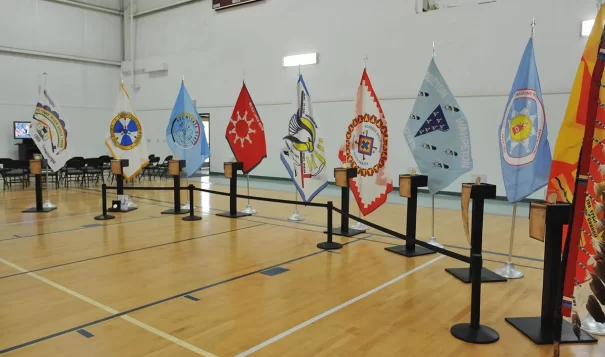News Based on facts, either observed and verified directly by the reporter, or reported and verified from knowledgeable sources.
Two Dakota tribes partner on broadband initiative
 An exhibit including a display of the tribal flags from the Cheyenne River, Crow Creek, Oglala, Rosebud, Sisseton Wahpeton, Standing Rock and Yankton Sioux Tribes. (Rapid City Journal File photo)
An exhibit including a display of the tribal flags from the Cheyenne River, Crow Creek, Oglala, Rosebud, Sisseton Wahpeton, Standing Rock and Yankton Sioux Tribes. (Rapid City Journal File photo)
Crow Creek Sioux Tribe and Sisseton Wahpeton Oyate to partner on broadband project
The Sisseton Wahpeton Oyate and Crow Creek Sioux Tribe are partnering to bring better broadband access to the Lake Traverse and Crow Creek reservations. On March 22, the two Dakota nations released a joint press release detailing a major broadband plan to increase high-speed internet access across both reservations.
The project aims to establish a 5G network, or a faster cellular network through a fiber optic network that improves the speed and quality of the service to connect communities around the reservations with reliable internet access. The partnership between the Sisseton Wahpeton Oyate and the Crow Creek Sioux Tribe in particular has the potential to affect between 5,000 and 10,000 people, according to Sisseton Wahpeton Oyate Chairman Garrett Renville.
“We have a lot of new leaders in the Great Plains and one of the things we discussed is working together,” Renville said. “We’re stronger as tribes when we come together and work together. The more tribes that work together, the better.”
The two Dakota nations began working together in the summer of 2023, and have now partnered to apply for a grant of approximately $25 million from the National Telecommunications Information and Administration’s Tribal Broadband Connectivity Program. Renville said he brought the idea of the broadband initiative to Crow Creek Sioux Tribe Chairman Peter Lengkeek in the summer of 2023 and they began working together on the grant.
The TBC program offers $3 billion to tribal governments for broadband deployment and development. Once grant money is dispersed this fall, the two Native nations will begin working to install new fiber cables and connect rural areas on the two reservations with reliable internet access.
High-speed internet access remains a large issue in Indigenous communities, especially rural communities. While 99 percent of households in urban areas have access to broadband service, only 65 percent of housing units on rural tribal land have the same level of access, according to the Bureau of Indian Affairs.
The barriers affecting broadband access and development in Indigenous communities can often be attributed to a lack of investment in tribal communities and complications with the vast rural environment. A majority of tribal lands across the United States are located on rough terrain or very rural areas. Rural communities are sparsely populated, increasing the cost for businesses to service the areas, the same goes for areas with rough terrain, according to the Bureau of Indian Affairs.
Data from the Federal Communications Commission and Bureau of Indian Affairs indicate that about 74 percent of rural non-tribal land is covered by at least one broadband provider offering fiber, cable or wireless technology that provides adequate internet usage. However, only about 47 percent of tribal communities have the necessary broadband coverage.
On the Lake Traverse Reservation, most sites tested had poor or no connection and many of the worst performing sites for internet service were around Agency Village – where the central tribal government and emergency services are located.
“Certain areas are complete dead spots and that can create issues with law enforcement,” Renville said. “Even in South Dakota we have a number of ambulatory services that use telehealth and this will improve that.”
The proposed project could also aid in digitizing agricultural practices on both reservations. With better internet connection, farmers can access real-time data, precision tools, and online resources to increase productivity.
“Having this available to us will be a game changer for everything,” Renville said.
Dateline:
RAPID CITY, S.D.
